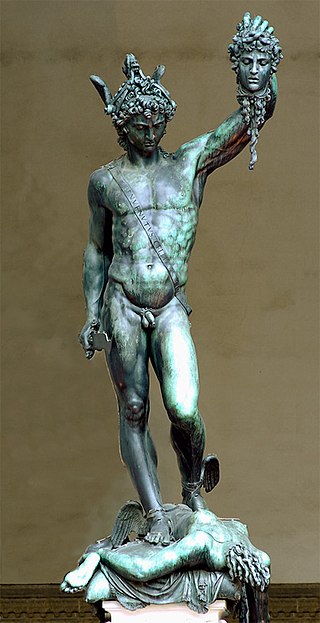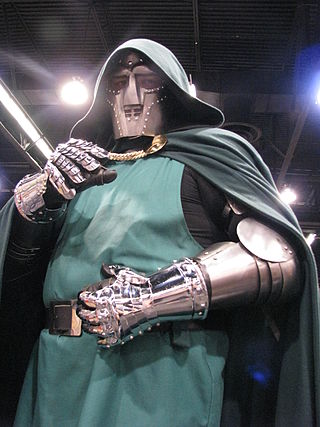
A cloaking device is a hypothetical or fictional stealth technology that can cause objects, such as spaceships or individuals, to be partially or wholly invisible to parts of the electromagnetic (EM) spectrum. Fictional cloaking devices have been used as plot devices in various media for many years.
Radagast the Brown is a fictional character in J. R. R. Tolkien's legendarium. A wizard and associate of Gandalf, he appears briefly in The Hobbit, The Lord of the Rings, The Silmarillion, and Unfinished Tales.

Invisibility is the state of an object that cannot be seen. An object in this state is said to be invisible. The phenomenon is studied by physics and perceptual psychology.

A cloak is a type of loose garment worn over clothing, mostly but not always as outerwear for outdoor wear, serving the same purpose as an overcoat, protecting the wearer from the weather. It may form part of a uniform. People in many different societies may wear cloaks. Over time cloak designs have changed to match fashion and available textiles.

Science fiction is a film genre that uses speculative, fictional science-based depictions of phenomena that are not fully accepted by mainstream science, such as extraterrestrial lifeforms, spacecraft, robots, cyborgs, mutants, interstellar travel, time travel, or other technologies. Science fiction films have often been used to focus on political or social issues, and to explore philosophical issues like the human condition.

Drexel Jerome Lewis Bixby was an American short story writer and scriptwriter. He wrote the 1953 story "It's a Good Life", which was the basis of a 1961 episode of The Twilight Zone and was included in Twilight Zone: The Movie (1983). He wrote four episodes for the Star Trek series: "Mirror, Mirror", "Day of the Dove", "Requiem for Methuselah", and "By Any Other Name". With Otto Klement, he co-wrote the story upon which the science fiction movie Fantastic Voyage (1966), the related television series, and the related Isaac Asimov novel were based. Bixby's final produced or published work so far was the screenplay for the 2007 science fiction film The Man from Earth.
The Ring of Gyges is a hypothetical magic ring mentioned by the philosopher Plato in Book 2 of his Republic (2:359a–2:360d). It grants its owner the power to become invisible at will. Through the device of the ring, this section of the Republic considers whether a rational, intelligent person who has no need to fear negative consequences for committing an injustice would nevertheless act justly.

Active camouflage or adaptive camouflage is camouflage that adapts, often rapidly, to the surroundings of an object such as an animal or military vehicle. In theory, active camouflage could provide perfect concealment from visual detection.

A magic item is any object that has magical powers inherent in it. These may act on their own or be the tools of the person or being whose hands they fall into. Magic items are commonly found in both folklore and modern fantasy. Their fictional appearance is as old as the Iliad in which Aphrodite's magical girdle is used by Hera as a love charm.

Weird West is a term used for the hybrid genres of fantasy Western, horror Western and science fiction Western. The term originated with DC's Weird Western Tales in 1972, but the idea is older as the genres have been blended since the 1930s, possibly earlier, in B-movie Westerns, comic books, movie serials and pulp magazines. Individually, the hybrid genres combine elements of the Western genre with those of fantasy, horror and science fiction respectively.

A magic ring is a mythical, folkloric or fictional piece of jewelry, usually a finger ring, that is purported to have supernatural properties or powers. It appears frequently in fantasy and fairy tales. Magic rings are found in the folklore of every country where rings are worn. Some magic rings can endow the wearer with a variety of abilities including invisibility and immortality. Others can grant wishes or spells such as neverending love and happiness. Sometimes, magic rings can be cursed, as in the mythical ring that was recovered by Sigurð from the hoard of the worm Fáfnir in Norse mythology or the fictional ring that features in The Lord of the Rings. More often, however, they are featured as forces for good, or as a neutral tool whose value is dependent upon the wearer.

The Invisible Plane is a plane appearing in DC Comics, commonly used by Wonder Woman as a mode of transport. It was created by William Moulton Marston and first appeared in Sensation Comics #1.

The Tarnhelm is a magic helmet in Richard Wagner's Der Ring des Nibelungen. It was crafted by Mime at the demand of his brother Alberich. It is used as a cloak of invisibility by Alberich in Das Rheingold. It also allows one to change one's form:
A cloak is a type of loose garment that is worn over indoor clothing.

A cloak of invisibility is an item that prevents the wearer from being seen. In folklore, mythology and fairy tales, a cloak of invisibility appears either as a magical item used by duplicitous characters or an item worn by a hero to fulfill a quest. It is a common theme in Welsh and Germanic folklore, and may originate with the cap of invisibility seen in ancient Greek myths. The motif falls under "D1361.12 magic cloak of invisibility" in the Stith Thompson motif index scheme.

In classical mythology, the Cap of Invisibility is a helmet or cap that can turn the wearer invisible, also known as the Cap of Hades or Helm of Hades. Wearers of the cap in Greek myths include Athena, the goddess of wisdom, the messenger god Hermes, and the hero Perseus. Those wearing the Cap become invisible to other supernatural entities, akin to a cloud of mist sometimes used to remain undetectable.

Doctor Doom is a fictional supervillain appearing in American comic books published by Marvel Comics. Since his debut in The Fantastic Four #5, the character has become the archenemy of the Fantastic Four, and has been included in almost every media adaptation of the Fantastic Four franchise, including film, television, and computer and video games. Usually depicted as the Monarch of the fictional nation Latveria, Doctor Doom has often been featured as an antagonist of other superheroes as well, including Black Panther, Doctor Strange, the X-Men and the Avengers.

Magic in fiction is the endowment of characters or objects in works of fiction or fantasy with powers that do not naturally occur in the real world.

The Invisible Man is a film series by Universal Pictures. The series consists of The Invisible Man, The Invisible Man Returns, The Invisible Woman, Invisible Agent, The Invisible Man's Revenge and Abbott and Costello Meet the Invisible Man. The film series borrows elements from H. G. Wells's novel The Invisible Man, but it focuses primarily on the idea of a serum that causes someone to go invisible and its side-effects.













